By Ministerial Order published on Sunday in BOE
Ministry of Transport, Mobility and Urban Agenda updates passenger transport conditions under Plan for Transition to New Normality
News - 2020.5.10
Within the field of city centre and suburban transport, the Order establishes that commuter railway services run by the State will gradually increase their offer until 100% of services are recovered, taking into account the need to adjust the offer of services to foreseeable demand and seeking to ensure maximum separation between passengers.
In addition, Order TMA/384/2020, of 3 May is amended in relation to the criteria of occupation for land transport. The Order published states that as many people can travel in private vehicles as there are seats, provided that they all live at the same address, in which case face masks will not be obligatory. This same criterion applies to complementary private transport in saloon cars.
In both cases, if not all of the occupants live at the same address, two people may travel on each row of seats, provided they use a face mask and respect the maximum possible distance between occupants.
This possibility extends to other vehicles that only have one row of seats, such as cabins in heavy vehicles, vans and similar, in which two people may travel provided that they wear a face mask and keep as far away from each other as possible. If not, only the driver may travel.
Furthermore, in passenger public transport in saloon cars, that is taxis and mini-cabs, two people may travel per row of seats, except in the front, where only the driver may travel. If all of the users live at the same address, then three people may travel in each row of seats except in the front.
Bus and rail travel
In the case of bus and rail travel, two situations are distinguished:
- In vehicles or carriages in which all the occupants must be seated, the operator will limit total occupation of the seats such that passengers have an empty seat to each side of them separating them from the next passenger. However, the operator may situate passengers travelling in adjacent seats that live together at the same address, thus increasing the capacity of the vehicle. At any event, the row of seats directly behind the driver will always remain empty on buses.
- In the event that the possibility also exists for passengers to remain standing, the benchmark is for no more than two passengers to stand per square metre in these areas and on 50% of the seats available.
Motorbikes and mopeds
The Order also regulates the conditions for travel by motorbike, moped and category L vehicles in general, which have two approved seats for the driver and one passenger.
Two people may travel on these vehicles provided that they wear a helmet with a built-in visor, or use a face mask in the event of not using this type of helmet, or if they live at the same address.
The driver and passenger must also wear gloves on motorbikes and mopeds that are shared with others.
Air and sea transport in the Balearic and Canary Islands
In the Balearic and Canary Islands, measures are established that regulate the mobility of people between islands under Phase 1, on air or sea transport, which are determined in coordination with the respective regional governments. The use of sea transport to the mainland is also made more flexible in the Balearic Islands.
Sea transport
The transportation by sea of passengers and vehicles is also re-established between the Spanish mainland and the Balearic Islands, and this traffic is also permitted on ferry lines between islands. On the ferry line between Ibiza and Formentera, the service will be offered three times a day in each direction.
Passengers are still banned from disembarking from ro-ro passenger ships and other passenger ships that provide regular services on ferry lines between the mainland and the Canary Islands, except drivers of tractor trucks to transport goods.
In the case of ferry lines between islands, both regional governments are authorised to establish the conditions for the provision of these services and to modify the number of sailings offered.
Furthermore, vessels used for recreational and sporting purposes are allowed to sail between ports and points on the coast in the same municipality and nearby uninhabited islands. In the case of the Canary Islands, this is extended to those vessels used to transport tourist passengers, which are not cruise ships or those engaged in teaching training and practical courses. In the Balearic Islands, only those vessels used for sporting and recreational activities are permitted for private use.
Air transport
In the Balearic and Canary Islands, the restrictions are lifted on commercial air travel routes between islands, while they remain for connections between the mainland and these regions.
In the case of connections between islands in each region, the Order establishes the reference fares to apply for each of the routes, and the minimum essential daily services on these routes, established for the period of the state of emergency.
It also provides that operators must guarantee, through the procedure they deem to be most fit, to separate passengers as far as possible. To this effect, the Order states that it is considered sufficient to offer the public only 50% of the capacity of the aircraft.
Finally, and at a national level, the conditions are also regulated for the exercise of air navigation and activities for recreational and sporting purposes, both in regions under Phase 0 and those under Phase 1.
Non official translation





